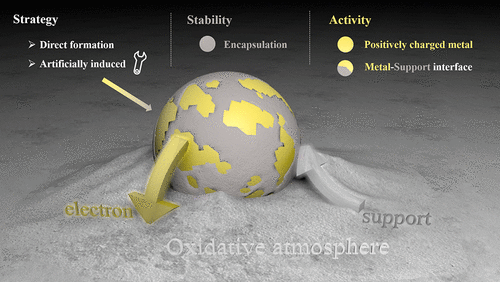Recently, our center published a review on the induced strong metal-support interaction in oxidative atmosphere (O-SMSI) and its catalytic application. This review summarized the work and related research contents of our center on the O-SMSI, and introduced the applications of O-SMSI in heterogeneous catalytic reactions and the challenges and opportunities for future development.

In 1978, Tauster et al. reported the classical strong metal–support interaction (C-SMSI) by observing significantly suppressed H2 and CO adsorption on Group-VIII noble-metal-reducible oxide systems after high-temperature reduction atmosphere treatment. SMSI is an important way to control the activity, stability and selectivity of supported metal catalysts. Oxidative SMSI (O-SMSI) was first observed by Mou et al. for Au/ZnO, wherein encapsulation overlayers were formed on Au nano rods under high-temperature oxidative atmosphere treatment, which broke down the long-term perception that SMSI depends on high-temperature reduction treatment. In the previous study, our center collaborated with Professors Botao Qiao and Tao Zhang’s group in DICP, first reported the strong interaction between gold/platinum group metals with hydroxyapatite (HAP) induced by high-temperature oxidative treatment (J. Am. Chem. Soc. 2016; Chem. Sci. 2018); by tuning O-SMSI, high temperature anti-sintering Au/HAP-TiO2 and Au/HAP-Fe2O3 catalysts with half encapsulated nanostructure were also developed ( Angew. Chem. Int. Ed. 2016; Catal. Today 2021). Subsequently, the electronic environment (Fermi level) of metal nanoparticles was modified by adding exogenous adsorbents, and O-SMSI was constructed in the noble metal system supported on TiO2, which provides a new method(Nat. Commun. 2019; ACS Catal. 2021)for the design and development of high temperature anti-sintering supported precious metal catalysts in high-temperature oxidation environment. In addition, O-SMSI was widely applied in heterogeneous catalytic reactions, and its positively charged metal sites, encapsulation structure and metal-support interface sites showed excellent catalytic properties in specific oxidation catalytic reactions. Finally, the authors summarized some common O-SMSI catalysts and prospected to the challenges and possible research directions in this field.
The review is published in "Accounts of chemical research" under the title "Oxidative-atmosphere-induced strong metal-support interaction and its catalytic application". The first author of this work is Guandong Wu, a postdoctoral researcher in collaboration with Prof. Junhu Wang. This work was financially supported by the National Natural Science Foundation of China, the International Partnership Program of Chinese Academy of Sciences, and China Postdoctoral Science Foundation.